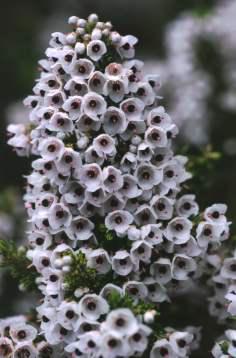Erica lowryensis
Erica lowryensis Bolus
Family: Ericaceae
Common names: Sir Lowry's Pass heath
Introduction
Like so many jewels of the fynbos, one has to be prepared to walk and climb to view this pretty erica which grows on the mountain ranges of the Kogelberg Biosphere Reserve as well as the Hottentots Holland Mountains in the Western Cape.

Description
Description
Erica lowryensis is a bushy shrub, which, when mature, can grow to a height of about 1 m.

The open, cup-shaped corolla is 4-5 mm long and has a slightly protruding pink style. The anthers are without appendages and are visible at the mouth of the flower. A profusion of white to pinkish white flowers is borne at the end of the branches in spring, from September to November.

Conservation Status
Status
Although Erica lowryensis is red listed as Rare, not being common in its habitat, it is not threatened because it occurs in mountain habitats and protected areas.
Distribution and habitat
Distribution description
The plants can be found in the Western Cape in the cool, moist areas of the Hottentots Holland Mountain range, the mountains above Betty's Bay and the Kogelberg.
Derivation of name and historical aspects
History
Erica lowryensis is part of section Melastemon. Melas is the Greek word meaning black, and stemon means stamens. This refers to the black stamens of some of the 14 species found in this section. Erica is derived from the Greek word ereike meaning break. It is believed that an infusion of certain ericas helps break kidney stones. Erica lowryensis is named after Sir Lowry's Pass where the type was collected. The type is the specimen on which the name of the plant is based and this is usually a dried herbarium specimen.
Growing Erica lowryensis
Grow
This plant can be grown from seed or by cuttings. To achieve optimum germination results, treat seed with smoke treatment before sowing. Sow seed in well-drained soil, cover seeds with a thin layer of soil and water lightly. Once germinated, seedlings can be fed with an organic seaweed-based fertilizer, which will strengthen the root system.
Take cuttings from actively growing shoots. Treat with a rooting hormone and place in a fine bark mix in a propagation unit with heated benches. Once rooted, plant in a well-drained soil mix for fynbos plants.
References
- Bean, A. & Johns A. 2005. Stellenbosch to Hermanus. South African Wild Flower Guide 5. Botanical Society of South Africa, Cape Town.
- Goldblatt, P. & Manning, J. 2000. Cape plants. A conspectus of the Cape flora of South Africa. National Botanical Institute, Cape Town and Missouri Botanical Garden.
- Schumann, D., Kirsten, G. & Oliver, E.G.H. 1992. Ericas of South Africa. Fernwood Press, Vlaeberg, Cape Town.
Credits
Berenice Carolus
Harold Porter National Botanical Garden
August 2006
Plant Attributes:
Plant Type: Shrub
SA Distribution: Western Cape
Soil type: Sandy, Loam
Flowering season: Spring, Early Summer
PH: Acid
Flower colour: White
Aspect: Shade
Gardening skill: Easy
Special Features:
Horticultural zones







Rate this article
Article well written and informative
Rate this plant
Is this an interesting plant?
Login to add your Comment
Back to topNot registered yet? Click here to register.